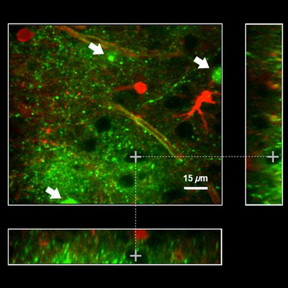New optical nanosensor improves brain mapping accuracy, opens way for more applications: Potassium-sensitive fluorescence-imaging method shines light on chemical activity within the brain
A new optical nanosensor enabling more accurate measurement and spatiotemporal mapping of the brain also shows the way forward for design of future multimodal sensors and a broader range of applications, say researchers in an article published in the current issue of Neurophotonics. The journal is published by SPIE, the international society for optics and photonics.
Neuronal activity results in the release of ionized potassium into extracellular space. Under active physiological and pathological conditions, elevated levels of potassium need to be quickly regulated to enable subsequent activity. This involves diffusion of potassium across extracellular space as well as re-uptake by neurons and astrocytes.

A new optical nanosensor enables more accurate brain mapping and opens the way for broader applications in future; Fig. 5 in a paper reporting on the work shows retention of a potassium nanosensor in the extracellular space.
Measuring levels of potassium released during neural activity has involved potassium-sensitive microelectrodes, and to date has provided only single-point measurement and undefined spatial resolution in the extracellular space.
With a fluorescence-imaging-based ionized-potassium-sensitive nanosensor design, a research team from the University of Lausanne was able to overcome challenges such as sensitivity to small movements or drift and diffusion of dyes within the studied region, improving accuracy and enabling access to previously inaccessible areas of the brain.
The work by Joel Wellbourne-Wood, Theresa Rimmele, and Jean-Yves Chatton is reported in "Imaging extracellular potassium dynamics in brain tissue using a potassium-sensitive nanosensor."
"This is a technological breakthrough that promises to shed new light -- both literally and figuratively -- on understanding brain homeostasis," said Neurophotonics associate editor George Augustine, of Duke University. "It not only is much less invasive than previous methods, but it adds a crucial spatial dimension to studies of the role of potassium ions in brain function."
This potassium-sensitive nanosensor is likely to aid future investigations of chemical mechanisms and their interactions within the brain, the authors note. The spatiotemporal imaging created by collected data will also allow for investigation into the possible existence of potassium micro-domains around activated neurons and the spatial extent of these domains. The study confirms the practicality of the nanosensor for imaging in the extracellular space, and also highlights the range of possible extensions and applications of the nanosensor strategy.
Source: Nanotechnology Now
- 371 reads
Human Rights
Ringing FOWPAL’s Peace Bell for the World:Nobel Peace Prize Laureates’ Visions and Actions

Protecting the World’s Cultural Diversity for a Sustainable Future

The Peace Bell Resonates at the 27th Eurasian Economic Summit

Declaration of World Day of the Power of Hope Endorsed by People in 158 Nations

Puppet Show I International Friendship Day 2020

